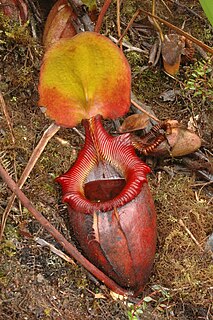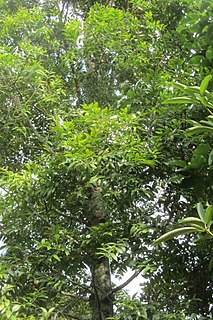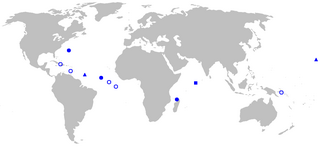
Hypsicalotes is a genus of the family Agamidae having a single species Hypsicalotes kinabaluensis found in Malaysia.

Illicium is a genus of flowering plants treated as part of the family Schisandraceae, or alternately as the sole genus of the Illiciaceae. It has a disjunct distribution, with most species native to eastern Asia and several in parts of North America, including the southeastern United States, Mexico, and the Caribbean. General common names include star anise and anisetree. The genus name comes from the Latin illicere.

Nepenthes × kinabaluensis, or the Kinabalu pitcher-plant, is the natural hybrid between N. rajah and N. villosa. It was first collected near Kambarangoh on Mount Kinabalu, Borneo by Lilian Gibbs in 1910 and later mentioned by John Muirhead Macfarlane as "Nepenthes sp." in 1914. Although Macfarlane did not formally name the plant, he noted that "[a]ll available morphological details suggest that this is a hybrid between N. villosa and N. rajah". It was finally described in 1976 by Shigeo Kurata as N. × kinabaluensis. The name was first published in Nepenthes of Mount Kinabalu, but was a nomen nudum at the time as it lacked an adequate description and information on the type specimen. The name was subsequently published validly by Kurata in 1984.

Agathis kinabaluensis is a tree of Borneo in the conifer family Araucariaceae. The specific epithet kinabaluensis is from the Latin, referring to the species being native to Mount Kinabalu in Sabah.
Dacrycarpus kinabaluensis is a species of shrubby conifer in the family Podocarpaceae. It is found only on Mount Kinabalu in Sabah, Malaysian Borneo.
The mountain serpent eagle, also known as the Kinabalu serpent eagle, is a bird of prey that is found in northern Borneo. It is found at altitudes of 1,000–4,100 metres (3,300–13,500 ft) in forest, especially where it becomes stunted. Where their range overlaps, the crested serpent eagle generally occurs at lower altitudes. The mountain serpent eagle is darker than the Bornean subspecies of the crested serpent eagle.
Meristogenys kinabaluensis is a species of frog in the family Ranidae. It is endemic to Borneo and is found in Sabah, Sarawak (Malaysia), and Kalimantan (Indonesia). The specific name refers to its type locality, Mount Kinabalu.

The Bornean leafbird, also known as the Kinabalu leafbird, is a species of bird in the family Chloropseidae. It is found in humid forest in Borneo, to which it is endemic. It has traditionally been considered a subspecies of the blue-winged leafbird, but differ in measurements and morphology, the female Borneon leafbird having a distinctive male-like plumage. The distribution of the two are known to approach each other, but there is no evidence of intergradation.
Illicium peninsulare is a species of plant in the family Schisandraceae. It is a tree endemic to Peninsular Malaysia. It is threatened by habitat loss.
Illicium tenuifolium is a species of flowering plant in the family Schisandraceae. It is a tree native to Indo-China and Peninsular Malaysia. It grows in tropical forests, including cloud forests.
Illicium ternstroemioides is a species of tree in the family Schisandraceae, or alternately, the Illiciaceae. It is native to northern Vietnam and Hainan Island in China.
Knema kinabaluensis is a species of plant in the family Myristicaceae. It is endemic to Borneo where it is confined to Sabah.

Prunus kinabaluensis is a species of flowering plant in the family Rosaceae. It is found in Borneo and the Philippines.

Illicium floridanum is an evergreen shrub native to the Gulf Coast area of the Southern United States, from Florida to Louisiana.

The whipnose anglers are a family, Gigantactinidae, of deep-sea anglerfishes. The family name is derived from the Greek words gigas, meaning "big", and aktis, meaning "ray". They are distinguished by the presence of a remarkably long lure, which may be longer than the body of the fish.
As of July 2016, the International Union for Conservation of Nature (IUCN) lists 238 conservation dependent species. 0.29% of all evaluated species are listed as conservation dependent. The IUCN also lists seven subspecies and five varieties as conservation dependent.

Rhynchactis is a genus of deep-sea anglerfish in the family Gigantactinidae, containing three species found worldwide at depths greater than 400 m (1,300 ft). Adult female Rhynchactis reach a standard length (SL) of 11–13 cm (4.3–5.1 in) and have a dark-colored, streamlined body and a relatively small head bearing a very long illicium. Unlike almost all other deep-sea anglerfishes, the illicium bears no bioluminescent esca at the tip. The mouth is almost devoid of teeth, and the inside of both jaws are covered by numerous white glands that are unique to this genus.
Chionanthus kinabaluensis is a tree in the family Oleaceae.
Sphenomorphus kinabaluensis is a species of skink found in Malaysia.

Tenompok Forest Reserve is a protected forest reserve in Ranau District of West Coast Division, Sabah, Malaysia. It was designated as a Class 1 Forest Reserve by the Sabah Forestry Department in 1984. Its area is 1,984 hectares (19.84 km2). A former reserve, the Kampung Bundu Tuhan Native Residence Reserve, occupied what is now the eastern portion of Tenompok. The reserve is mountainous, reaching 1,660 metres (5,450 ft) above sea level. Vegetation consists of lower montane forest and montane kerangas forest. Both share a similar species composition, although trees in montane keranga forests are smaller. The reserve's Tomis River is a tributary of the Tuaran River. The area of the reserve has never received significant logging, aside from small amount near what are now its borders. This small logging is thought to be carried out by nearby villages for local use. There is also some agricultural encroachment. The reserve lies between Kinabalu Park and Crocker Range National Park. One farmer has a house within the reserve. There are several settlements around the reserve, along with agricultural land.










